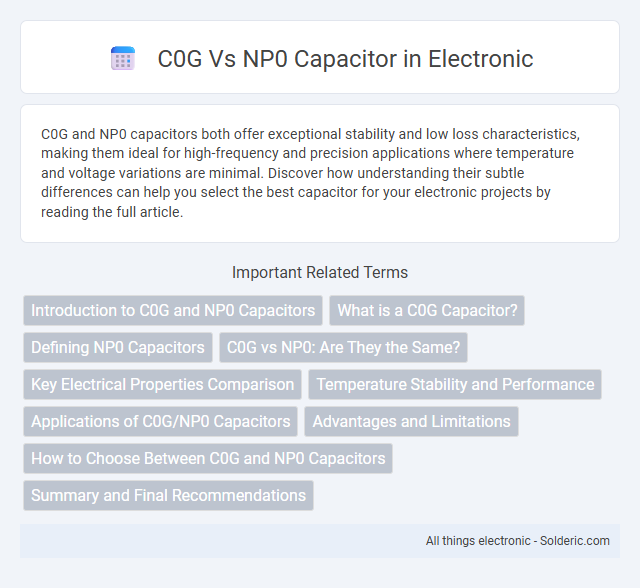C0G and NP0 capacitors both offer exceptional stability and low loss characteristics, making them ideal for high-frequency and precision applications where temperature and voltage variations are minimal. Discover how understanding their subtle differences can help you select the best capacitor for your electronic projects by reading the full article.
Comparison Table
| Feature | C0G Capacitor | NP0 Capacitor |
|---|---|---|
| Dielectric Material | Class 1 Ceramic | Class 1 Ceramic |
| Temperature Stability | +-30 ppm/degC | +-30 ppm/degC |
| Capacitance Range | ~1 pF to 1 uF | ~1 pF to 1 uF |
| Dielectric Constant | ~10 to 100 | ~10 to 100 |
| Equivalent Series Resistance (ESR) | Low | Low |
| Application | High precision, RF circuits, timing | High precision, audio, timing circuits |
| Stability Over Time | Excellent | Excellent |
| Voltage Rating | Up to 1000 V | Up to 1000 V |
| Common Uses | Filters, oscillators, resonators | Filters, timing, precision analog circuits |
Introduction to C0G and NP0 Capacitors
C0G and NP0 capacitors are types of ceramic capacitors known for their stable electrical properties and low temperature coefficients, making them ideal for precision applications. Both use Class 1 dielectric materials, with C0G specifically categorized for its extremely low capacitance change over temperature, typically +-30 ppm/degC, while NP0 capacitors maintain similar stability with minimal variation. You can rely on these capacitors for applications requiring high reliability and minimal signal distortion, such as RF circuits and timing devices.
What is a C0G Capacitor?
A C0G capacitor is a type of ceramic capacitor known for its exceptional stability and low dielectric loss, making it ideal for high-frequency and precision applications. It features a NP0 (Negative-Positive-Zero) dielectric material, which ensures minimal capacitance change over temperature, voltage, and time. You can rely on C0G capacitors for applications demanding consistent performance and high reliability.
Defining NP0 Capacitors
NP0 capacitors, also known as C0G capacitors, are a type of ceramic capacitor characterized by a stable capacitance over a wide temperature range, typically -55degC to +125degC. Their dielectric material offers minimal temperature coefficient, low dielectric losses, and high insulation resistance, making them ideal for precision timing and filtering applications. Choosing an NP0 capacitor ensures your circuit maintains consistent performance in environments requiring stability and reliability.
C0G vs NP0: Are They the Same?
C0G and NP0 capacitors share nearly identical electrical characteristics, both representing Class 1 ceramic dielectrics with minimal temperature coefficient, ensuring stable capacitance over a wide temperature range (-55degC to +125degC). The term C0G is standardized under EIA and IEC, while NP0 is a manufacturer-specific designation but functionally equivalent, indicating zero capacitance change with temperature. Both types are ideal for precision timing and filtering applications due to their low loss and high stability.
Key Electrical Properties Comparison
C0G and NP0 capacitors share similar ultra-stable temperature coefficients of 0 +-30 ppm/degC, making them ideal for precision applications requiring minimal capacitance change with temperature variations. Both exhibit low dielectric absorption, high insulation resistance, and negligible aging, ensuring long-term stability and reliability in your circuits. The primary distinction lies in their specification standards; NP0 is the EIA designation, while C0G follows the IEC standard, but electrically, they perform equivalently.
Temperature Stability and Performance
C0G capacitors offer excellent temperature stability with minimal capacitance change over a wide temperature range, typically +-30 ppm/degC, making them ideal for precision circuits. NP0 capacitors share similar characteristics, providing consistent performance and low dielectric absorption in varying thermal conditions. Your choice between C0G and NP0 will ensure reliable operation with stable capacitance values in temperature-sensitive applications.
Applications of C0G/NP0 Capacitors
C0G/NP0 capacitors are highly suited for precision timing and frequency control applications due to their exceptional stability, low loss, and minimal capacitance variation over temperature. These capacitors are commonly used in RF circuits, oscillators, filters, and sensor interfaces where preserving signal integrity is critical. Your electronic designs benefit from their reliability in high-frequency and low-noise environments, ensuring optimal performance in demanding applications.
Advantages and Limitations
C0G capacitors offer superior temperature stability with a negligible capacitance change of less than 30 ppm/degC, making them ideal for precision applications requiring low dielectric losses and high reliability. NP0 capacitors, while similar in performance, are typically used in general-purpose circuits due to their lower cost and availability but may exhibit slightly higher losses and a broader tolerance range. Both types have voltage limitations, often capped around 50V to 100V, but C0G capacitors excel in high-frequency and low-loss environments, whereas NP0 capacitors balance cost-effectiveness with acceptable stability.
How to Choose Between C0G and NP0 Capacitors
Choosing between C0G and NP0 capacitors depends primarily on the specific application requirements related to temperature stability and dielectric properties. C0G capacitors, known for their Class 1 ceramic dielectric, offer extremely low temperature coefficient and minimal capacitance change, making them ideal for high-frequency circuits and precision timing applications. Your selection should favor NP0 capacitors when you require consistent performance with negligible distortion and low losses over a wide temperature range in sensitive analog and RF circuits.
Summary and Final Recommendations
C0G and NP0 capacitors are essentially the same type of Class 1 ceramic capacitors with minimal temperature coefficient and excellent stability, often used in precision circuits requiring low loss and high reliability. Both offer superior performance in high-frequency and high-voltage applications, making them ideal for timing, filtering, and RF circuits. For your design needs demanding consistency and low noise, selecting either C0G or NP0 capacitors ensures optimal electrical characteristics and long-term stability.
C0G vs NP0 capacitor Infographic

 solderic.com
solderic.com